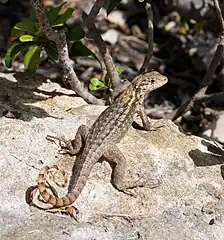| Leiocephalidae | |||
| Frost & Etheridge, 1989[1] | |||
 Przedstawiciel rodziny – Leiocephalus carinatus armouri | |||
| Systematyka | |||
| Domena | |||
|---|---|---|---|
| Królestwo | |||
| Typ | |||
| Podtyp | |||
| Gromada | |||
| Rząd | |||
| Infrarząd | |||
| Rodzina |
Leiocephalidae | ||
| Typ nomenklatoryczny | |||
|
Leiocephalus carinatus J.E. Gray, 1827 | |||
| Synonimy | |||
| |||
| Rodzaje i gatunki | |||
| |||
Leiocephalidae – monotypowa rodzina jaszczurek z infrarzędu Iguania w obrębie rzędu łuskonośnych (Squamata).
Zasięg występowania
Rodzina obejmuje gatunki występujące na Antylach (Kuba, Kajmany, Turks i Caicos, Haiti i Dominikana) i Bahamach[4][5].
Systematyka
Etymologia
Leiocephalus: gr. λειος leios „gładki”[6]; -κεφαλος -kephalos „-głowy”, od κεφαλη kephalē „głowa”[7].
Podział systematyczny
Leiocephalidae została wyłoniona z lawanikowatych (Tropiduridae), gdzie rodzaj Leiocephalus był klasyfikowany w podrodzinie Leiocephalinae. Część systematyków nie zaakceptowało podniesienia Leiocephalinae do rangi rodziny[8]. Do rodziny należy jeden rodzaj z następującymi występującymi współcześnie gatunkami[4]:
- Leiocephalus barahonensis Schmidt, 1921
- Leiocephalus carinatus Gray, 1827
- Leiocephalus cubensis (Gray, 1840)
- Leiocephalus cuneus Etheridge, 1964
- Leiocephalus endomychus Schwartz, 1967
- Leiocephalus eremitus (Cope, 1868)
- Leiocephalus etheridgei Pregill, 1981
- Leiocephalus greenwayi Barbour & Shreve, 1935
- Leiocephalus herminieri (Duméril & Bibron, 1837)
- Leiocephalus inaguae Cochran, 1931
- Leiocephalus jamaicensis Etheridge, 1966
- Leiocephalus loxogrammus (Cope, 1887)
- Leiocephalus lunatus Cochran, 1934
- Leiocephalus macropus (Cope, 1863)
- Leiocephalus melanochlorus Cope, 1863
- Leiocephalus onaneyi Garrido, 1973
- Leiocephalus partitus Pregill, 1981
- Leiocephalus personatus (Cope, 1863)
- Leiocephalus pratensis (Cochran, 1928)
- Leiocephalus psammodromus Barbour, 1920
- Leiocephalus punctatus Cochran, 1931
- Leiocephalus raviceps Cope, 1863
- Leiocephalus rhutidira Schwartz, 1979
- Leiocephalus schreibersii (Gravenhorst, 1838)
- Leiocephalus semilineatus Dunn, 1920
- Leiocephalus sixtoi Köhler, Bobadilla & Hedges, 2016
- Leiocephalus stictigaster Schwartz, 1959
- Leiocephalus varius Garman, 1887
- Leiocephalus vinculum Cochran, 1928
Opisano również kilka gatunków wymarłych (gatunki L. cuneus, L. etheridgei, L. jamaicensis i L. partitus wymienione są na liście gatunków The Reptile Database, ponieważ czas ich wymarcia być może przypada na czasy współczesne[4]):
- Leiocephalus apertosulcus Etheridge, 1965[9] (Dominikana; plejstocen)
- Leiocephalus cuneus Etheridge, 1964[10] (Barbuda; plejstocen)
- Leiocephalus etheridgei Pregill, 1981[11] (Portoryko; plejstocen)
- Leiocephalus jamaicensis Etheridge, 1966[12] (Jamajka; plejstocen)
- Leiocephalus partitus Pregill, 1981[13] (Portoryko; plejstocen)
- Leiocephalus roquetus Bochaton, Charles & Lenoble, 2021[14] (Gwadelupa)
- Leiocephalus septentrionalis Wellstead, 1982[15] (Stany Zjednoczone; miocen).
Uwagi
- ↑ Pisownia oryginalna, takson zdefiniowany w randze podrodziny.
Przypisy
- 1 2 D.E. Frost & R.E. Etheridge. A Phylogenetic Analysis and Taxonomy of Iguanian Lizards (Reptilia: Squamata). „University of Kansas Museum of Natural History Miscellaneous Publications”. 81, s. 45, 1989. (ang.).
- ↑ D.R. Frost, R. Etheridge, D. Janies & T.A. Titus. Total evidence, sequence alignment, evolution of Polychrotid lizards, and a reclassification of the Igunaia (Squamata: Iguania). „American Museum Novitates”. 3343, s. 13, 2001. (ang.).
- ↑ J.E. Gray. A description of a new genus and some new species of saurian reptiles; with a revision of the species of chameleons. „The Philosophical Magazine”. New and United Series. 2, s. 207, 1827.
- 1 2 3 P. Uetz & J. Hallermann: Higher taxa: Leiocephalidae. The Reptile Database. [dostęp 2023-04-15]. (ang.).
- ↑ R. Midtgaard: Leiocephalus. RepFocus. [dostęp 2023-04-15]. (ang.).
- ↑ Jaeger 1944 ↓, s. 121.
- ↑ Jaeger 1944 ↓, s. 44.
- ↑ Family Tropiduridae (Neotropical Ground Lizards). J. Craig Venter Institute. [dostęp 2008-11-02]. [zarchiwizowane z tego adresu (19 lipca 2010)]. (ang.).
- ↑ R. Etheridge. Fossil lizards from the Dominican Republic. „Quarterly Journal of the Florida Academy of Sciences”. 28 (1), s. 91, 1965. JSTOR: 24314646. (ang.).
- ↑ R. Etheridge. Late Pleistocene lizards from Barbuda, British West Indies. „Bulletin of the Florida State Museum (Biological Sciences)”. 9 (2), s. 48, 1964. (ang.).
- ↑ Pregill 1981 ↓, s. 35.
- ↑ R. Etheridge. An extinct lizard of the genus Leiocephalus from Jamaica. „Quarterly Journal of the Florida Academy of Sciences”. 29 (1), s. 49, 1966. JSTOR: 24314959. (ang.).
- ↑ Pregill 1981 ↓, s. 39.
- ↑ C. Bochaton, L. Charles & A. Lenoble. Historical and fossil evidence of an extinct endemic species of Leiocephalus (Squamata: Leiocephalidae) from the Guadeloupe Islands. „Zootaxa”. 4927 (3), s. 386, 2021. DOI: 10.11646/zootaxa.4927.3.4. (ang.).
- ↑ C.F. Wellstead. Lizards from the Lower Valentine Formation (Miocene) of northern Nebraska. „Journal of Herpetology”. 16 (4), s. 365, 1982. DOI: 10.2307/1563566. (ang.).
Bibliografia
- Edmund C. Jaeger, Source-book of biological names and terms, wyd. 1, Springfield: Charles C. Thomas, 1944, s. 1–256, OCLC 637083062 (ang.).
- G. Pregill. Late Pleistocene herpetofaunas from Puerto Rico. „University of Kansas Museum of Natural History Miscellaneous Publication”. 71, s. 1–72, 1981. (ang.).
